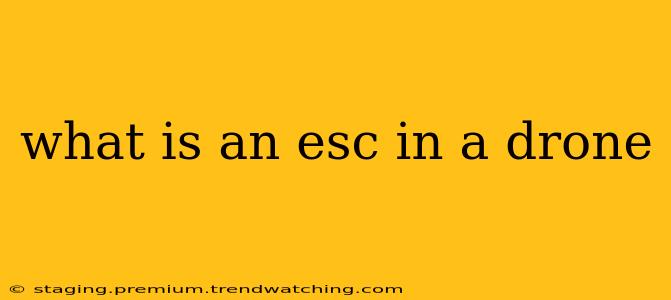What is an ESC in a Drone?
An ESC, or Electronic Speed Controller, is a crucial component in a drone's power system. It's the brains behind the operation of the drone's motors, acting as an intermediary between the flight controller and the motors themselves. Think of it as the translator that takes the instructions from the flight controller and converts them into the appropriate power signals to control the speed and direction of the spinning motors. Without a properly functioning ESC, your drone simply won't fly.
Understanding the Role of the ESC
The flight controller tells the drone where to go and how to maneuver, but it doesn't directly control the motor speeds. That's the job of the ESC. The flight controller sends signals to the ESC, indicating the desired speed and direction of rotation for each motor. The ESC then regulates the power supplied to the motor based on these instructions. This allows for precise control of the drone's movements, enabling it to ascend, descend, hover, and move in any direction.
How an ESC Works: A Simplified Explanation
The ESC works by using transistors to switch the power from the battery to the motor rapidly. This process, called Pulse Width Modulation (PWM), creates a variable voltage signal that controls the motor's speed. A higher PWM signal (meaning the power is switched on for a longer duration) results in a faster motor speed. Conversely, a lower PWM signal translates to a slower speed. This rapid on/off switching allows for smooth and precise control of the motor.
Frequently Asked Questions about Drone ESCs
Here are some common questions people have about ESCs in drones, addressed in detail:
1. What happens if my ESC fails?
If an ESC fails, the corresponding motor will either stop working entirely or function erratically. This will lead to a loss of control, making the drone unstable and potentially causing a crash. Symptoms of a failing ESC can include unusual motor behavior, flickering lights, or beeping noises.
2. What are the different types of ESCs?
ESCs come in various sizes and specifications, depending on the drone's size and power requirements. They are categorized based on factors like the voltage they can handle (e.g., 2S, 3S, 4S, referring to the number of lithium polymer battery cells), the current they can deliver (measured in Amps), and their communication protocol (e.g., OneShot, MultiShot, DSHOT). Choosing the right ESC is crucial for optimal performance and safety.
3. How do I choose the right ESC for my drone?
Selecting the appropriate ESC involves considering the motor's kV rating (a measure of RPM per volt), the battery's voltage and current capacity, and the desired flight characteristics. Always ensure that the ESC's specifications exceed the motor's requirements to prevent overheating and damage. It's recommended to consult your drone's specifications or seek advice from experienced drone builders.
4. Can I repair a faulty ESC?
While some minor issues might be repairable by experienced individuals with specialized tools and knowledge, repairing a damaged ESC is generally not recommended for beginners. Replacing a faulty ESC is usually more practical and safer. The internal components are very small and sensitive, and improper repair can lead to further damage or create a safety hazard.
5. How do I connect an ESC to a drone?
Connecting an ESC requires careful attention to detail. It needs to be connected correctly to both the battery and the flight controller. The connections are usually color-coded, and the correct connections should be followed carefully. Incorrect connections can damage both the ESC and the other components. Always consult the specific instructions for your particular drone and ESC model. Improper connections can cause serious damage to your equipment.
This comprehensive explanation should provide a solid understanding of what an ESC is and its critical role in drone operation. Remember, safety is paramount when working with drones; always follow proper procedures and seek expert advice when needed.

